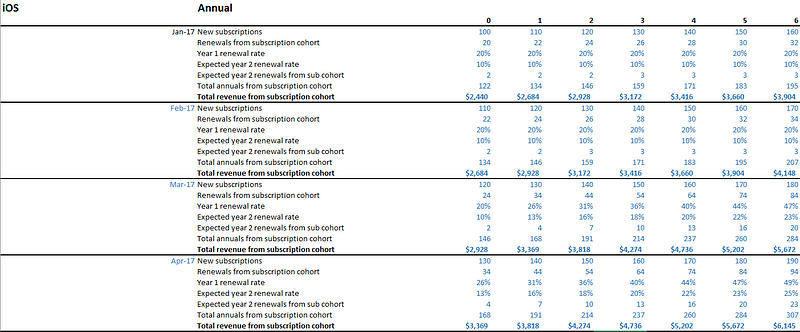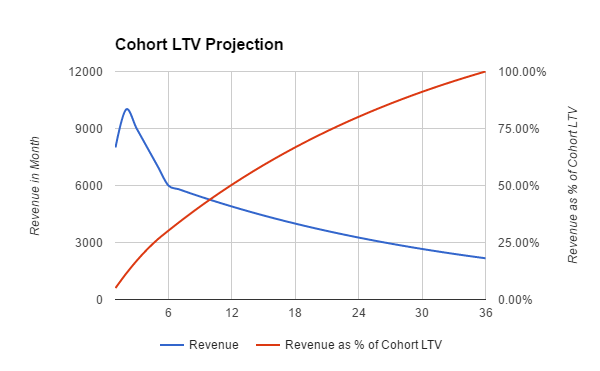
This is the story of two startups that developed a profitable paid marketing strategy together.
Keepsafe is a four-year old company that leads consumer privacy globally. Our secure private photo vault on iOS and Android serves 50 million people.
Open Oceans is a six-month old digital growth agency with a stellar reputation and a laser focus on results.
In this post, we’ll give you background about what an LTV analysis is and why it matters for startups launching paid marketing campaigns. We’ll also describe how we made a data-driven LTV model together and use this model to guide our paid marketing strategy.
If you want more information on how an LTV model can be used to analyze your business check out these posts by Jonathan Hsu at Social Capital.
What’s an LTV analysis?
It’s a financial model that helps you calculate the lifetime value of a customer based on expectations about:
- How much and how often a customer will pay you for your product or service
- What it will cost you to deliver this service
- How long the customer will continue to pay you
A quality LTV analysis should capture how customers behave over time and how this impacts profitability, so it’s important to use as much historical data as possible. An LTV analysis will also show you each customer’s value with respect to your business and how much you can spend on acquisition without losing money.
Why it’s important
Keepsafe’s ability to attract millions of users organically is a testament to building a product people want and a brand people trust. We’ve invested in both over the years. But we also recognize that eventually we’ll need alternate strategies beyond organic growth. We must be prepared to play offense as competitors enter the market and vie for customer attention. Our position as a fast-growing, category-leading company depends upon our ability to build awareness and share Keepsafe’s value with new users. That’s why we felt compelled to explore paid marketing. The LTV model sets the guardrails for a paid marketing strategy.
Before we increased our paid marketing budget, we wanted to be sure there was justification to do so. As a startup, an investment in marketing comes at the cost of other growth tactics. We needed to get clear on what a new app install was worth to Keepsafe in terms of real revenue. We knew that an LTV model would assure that we weren’t wasting precious resources and that our marketing strategy remained profitable. With Open Oceans, the partners we hired to bring a data-driven approach to paid marketing, we built an empirical LTV model grounded in historical data and conservative forecasts.
If your startup is thinking about kicking off paid marketing efforts, especially if you are working with a third-party agency, the time is right to get cracking on an LTV analysis. Additional benefits are:
- Understanding how marketing different products at different prices affects the value you realize from your customers
- Identifying key points in time where customer behavior changed
- Assessing how customer behavior should impact cash management
Step 1: Design first!
If you are a dynamic, early-stage startup like Keepsafe, you’ll need a model that’s customized to your business, not just a traditional LTV formula. (Basic LTV models use point-in-time equations that don’t account for changes in customer behavior, costs, nor revenue.) Since Keepsafe has a global footprint and makes consistent product improvements, we anticipated different lifetime values for customers across varying cohorts, locales, and operating platforms. Keepsafe’s app also uses a freemium model: people can download it for free and subscribe annually for premium privacy features and more storage. So Keepsafe often realizes the value from an install months after a user first downloads the app.
We needed a comprehensive model that would allow us to:
- Generate a perpetual LTV for every Keepsafe install to set a CPI (cost-per-install) target for marketing
- Normalize user cohorts based on monthly installs for comparison
- Benchmark subscription rates and build forecasts for expected future value
- Set assumptions to understand how changes in cohort behavior impact future economics
Step 2: Organize your data
For the best possible analysis, we pulled years of data points extending back to Keepsafe’s launch. Key data included monthly installs, subscriptions, renewals, and revenue. Your initial install figure should always be the basis for your LTV analysis. Churned users shouldn’t be removed, since you paid for them!
We broke cohorts up by month of install and operating system. For example, everyone who installed Keepsafe in December of 2014 on iOS fell into a single cohort. Note: Keepsafe puts users’ privacy first. We anonymize all user data and only use it in aggregate.
We organized the data into a grid for comparison by cohort age.

This is vital, because we can see how key improvements to our business like product changes and pricing impact LTV over time. For example, we recognized that a change in subscription packages increased LTV in all cohorts following the change.
Comparing cohorts by age gives visibility to insights and business performance trends that are otherwise obscured.
Step 3: Build the model
To understand the value of each install, first we needed to look at how customers behaved over time. Since Keepsafe’s revenue model relies on premium subscriptions in exchange for enhanced security features and additional storage, we needed to know the following:
- Did a user subscribe to Keepsafe’s premium version?
- If so, in what month did that user subscribe?
- Did the same user renew his/her subscription?
Depending on your business model, other behaviors that may be important to analyze include customer engagement, purchasing behavior, or contribution margin.
In order to analyze our LTV, we calculated the number of users in each cohort who subscribed to the premium version in a given month, then divided this by the number of installs within each cohort to set expected subscription rates for every month. We also generated expectations for renewal likelihood. Because some cohorts don’t have full historical data (i.e. last month’s cohort only has 1 month of data), we built our model to only use actual subscription rates for these calculations.
Using average subscription and renewal rates, we were able to generate a 36-month forecast to set subscription and renewal expectations. We also calculated the total revenue we’d expect any cohort to generate over a 36-month period.
For Keepsafe, 36 months was a conservative timeline (ensuring that we didn’t overcount future value) that also honored our relative youth as a company with a shorter customer lifespan. Your startup may choose longer timelines with more historical data.
Step 4: Make flexible assumptions
Though we used historical data to develop forecasting, we still wanted control over forecasting assumptions to see how different customer trends might impact our business.
To achieve this, we built a control center that allows us to change how we forecast future value.

Our flexible assumptions centered around expected renewal and retention rates among cohorts. Since these behaviors impact the lifetime value of Keepsafe’s customers, it was important to see how our business would be impacted by changes.
Depending on industry and business size, here are other factors you may want to keep adjustable:
- Economic changes (macro & micro)
- Changes in capital structure
- Changes in unit economics
- Changes in fixed cost structure
With key data organized, forecasts built, and assumptions set, we were now able to compile a single view of the LTV for all monthly cohorts.

Step 5: Understanding cash flows
One key question we had was how quickly we realize value from acquired customers.
As discussed, many of Keepsafe’s users try the free version of the app for a few months before upgrading to a paid subscription. Because we use this LTV analysis to guide our paid marketing budgets, we wanted to understand what our payback period would be.
Here we assessed how much revenue a cohort generated, on average, each month.
Then we assessed the cumulative percentage of a cohort’s LTV at the end of each month.

In this example, the red line represents the percentage of total cohort LTV that has been realized by the end of each month. As you see, this cohort only achieves 50% of its total LTV within its first year after install.
For paid marketing, this means that if the business sets its CPI at 100% of LTV, then the business needs enough cash on hand to float its marketing spend while waiting to accrue the full lifetime value of acquired users. For many startups, this cash float is risky, so it’s important to understand how value actually accrues over time and use this to inform your budgets for acquiring new users.
Once you have enough data, you can also study the time it takes to realize acquired users’ full lifetime value by marketing channel (e.g., Google Search, Facebook) and inform your marketing strategy and spend accordingly.
Step 6: Close the Loop
In order to set paid marketing budgets, we needed to know whether the customers that we acquired through paid marketing were as valuable as organic installs.
Mobile app tracking and attribution companies provide software that allows us to anonymously track and aggregate the actions of users once they have installed our app. This way, we can understand what percentage of paid users eventually subscribe to our app, compare them to organic users and evaluate the efficiency of our marketing channels.
When you validate predicted revenues with an LTV analysis, you can see whether paid marketing activities are driving a return on investment and CPI targets are set appropriately. At this point, you’ll have the guidance to put a bulletproof paid marketing strategy in play and scale spend.
Key results from LTV findings
With our LTV findings in hand, Keepsafe has been able to thoughtfully reset marketing budgets with confidence. Setting clear targets has allowed us to rapidly test and optimize paid marketing activities with Open Oceans and ensure we’re working toward the same goals with a common definition for success.


